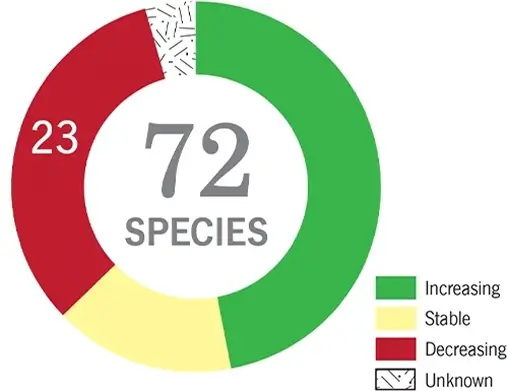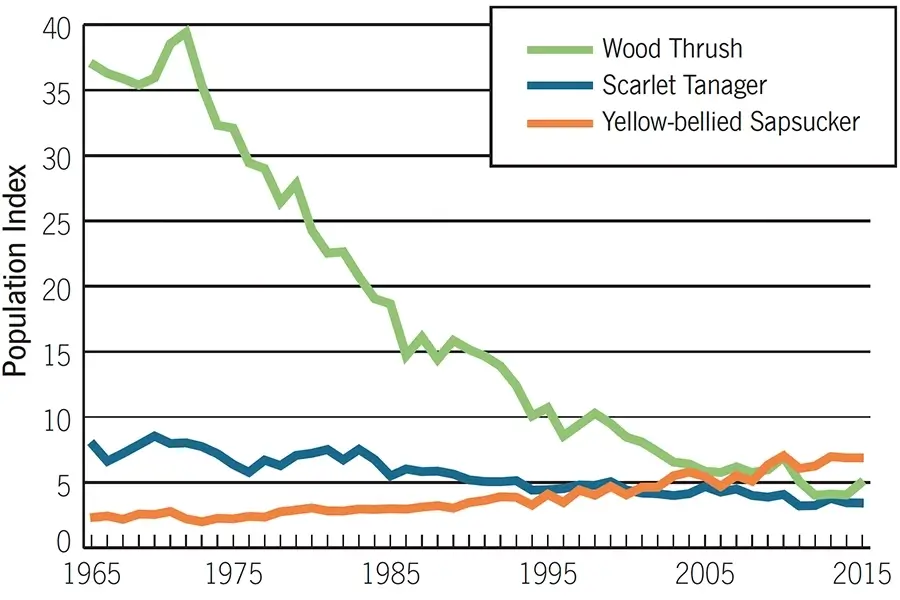This habitat occurs throughout the state and includes a wide variety of forests and tree species, including oaks, pines, hemlock, beech, maple, and birch. It includes four forest types from the WAP: hemlock-hardwood-pine, Appalachian oak-pine, northern hardwoods-conifer, and floodplain forest. Embedded within these are small areas of swamp that also support forest birds. Many of the species that use hardwood-mixed forests are generalists that also occur in spruce-fir forests and developed areas.

Ruffed Grouse
Chimney Swift
American Woodcock
Northern Goshawk
Olive-sided Flycatcher
Eastern Whip-poor-will
Veery
Wood Thrush
Purple Finch
Cerulean Warbler
Canada Warbler
Scarlet Tanager
Broad-winged Hawk
Barred Owl
Pileated Woodpecker
Red-eyed Vireo
Baltimore Oriole
Ovenbird
Black-throated Blue Warbler
Black-throated Green Warbler
Rose-breasted Grosbeak

Hardwood-mixed forests support the largest number of breeding species in New Hampshire. The good news is that two-thirds of the bird species in this habitat are either stable or increasing. Most of these are familiar year-round residents or short-distance migrants, including species such as Wild Turkey, Downy Woodpecker, American Robin, and Chipping Sparrow. Declining species comprise a third of the total habitat group, and include several long-distance migrants like Wood Thrush, American Redstart, Scarlet Tanager, and Baltimore Oriole. Many of these declining species require unfragmented interior forests, and have likely suffered from increasing development in formerly forested parts of the state. Many forest-interior species also nest on the ground and these are declining more than those species nesting above the ground in cavities or tree branches.

By far the most significant threat facing this habitat group is development, which causes both direct loss of habitat and habitat fragmentation. Fragmentation reduces uninterrupted forest tracts to small and/or isolated patches of forest. It also introduces new threats caused by proximity to people and developed areas. Among these risks are predation by cats, raccoons, skunks, and squirrels, reduced reproductive success due to brood parasites like the Brown-headed Cowbird, fatalities from encounters with windows, and exposure to herbicides and pesticides.
Invasive insects pose a significant threat to New Hampshire’s forests, whether from host-specific insects like the hemlock woolly adelgid and the emerald ash borer or more generalist species like the Asian longhorn beetle and gypsy moth. These pests have the potential to alter the tree species composition of our forests, with as yet unknown effects on birds. In some settings, invasive plants can displace native species, and many non-native plants support fewer insect species than native ones, thus providing less food for native birds.
There is increasing evidence that calcium depletion from forest soils, a side effect of acid deposition, can result in less calcium available for birds to make eggshells. This has the potential to significantly affect avian reproductive success. This is new research, and more detailed results are not yet available.
Focus on preserving unfragmented blocks of forest land: the bigger the better. At the municipal level, this means pursuing regulatory tools for maintaining intact habitats and land conservation opportunities, both within the municipality and between or among municipalities. Efforts to prevent the spread of invasive species need to intensify.
The relatively few species in this habitat without good trend data are primarily birds of prey that are poorly sampled by most monitoring programs because they are dispersed and hard to detect. More data are needed on the magnitude of calcium depletion effects of acid rain and the impacts of invasive species.
Many threats faced by birds are tied to the habitats where they breed. Explore the habitats and learn more about each one’s characteristics, population trends, threats, and conservation actions.
Contact Headquarters

National Wildlife Federation Affiliate
Website By CleverLight
Information for the species profiles on this website was compiled from a combination of the sources listed below.
The Birds of New Hampshire. By Allan R. Keith and Robert B. Fox. 2013. Memoirs of the Nuttall Ornithological club No. 19.
Atlas of the Breeding Birds of New Hampshire. Carol R. Foss, ed. 1994. Arcadia Publishing Company and Audubon Society of New Hampshire
Birds of the World. Various authors and dates. Cornell Laboratory of Ornithology.
Data from the Breeding Bird Survey
Data from the Christmas Bird Count